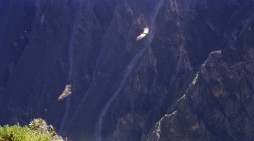
Photo. Condors flying. Like a Steel plane, the
legendary condors rose up from the world's second deepest valley, and dived down
again in a tremendous speed.
Early in the morning we drove further on a bumpy and narrow road. We passed
some few small Indian villages with beautiful decorated old churches, and there
was no doubt that we were in a very remote area.
The people who live here are decedents of the Incas. As
their ancestors they still use terraces for farming.
The Colca Canyon, is considered to be the world's second deepest canyon.
It`s located only a half-day drive from Arequipa through the Augada Blanca
National Reserve (ca. 170 Kilometres away from the city). This canyon cuts
through a region occupied by people whose lives have changed little since Inca
times.
|
Photo.
Beatiful nature on the rocky and narrow road to Colca Canyon.
In the area it`s possible to see stone
carvings, cave paintings and thermal baths.
Soon I would be able to see condors flying around searching for
food along the sides of the canyon.
|
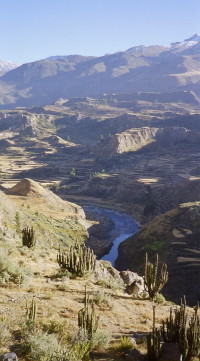
|
Finally we reached the best site for spotting condors; Cruz del Condor on the
top of the Colca Canyon, which is located about 60 kilometres beyond Chivay.
This canyon has been known as the deepest in the world.
The deepest sections are 3400 metres deep. It's assumed to be twice as deep as
the Grand Canyon in the US, but in recent time it has been more commonly
accepted that Canyon del Cotahuasi nearby as deeper. The Colca Canyon has been
known under different names: The Lost Valley of the Incas, The
Valley of Wonders, and The Valley of Fire and The Territory of the Condor.
|
Photo. Colca Canyon - the second
deepest in the world.
It`s so deep that it almost impossible to see
the bottom. |
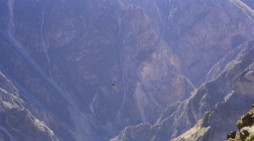 |
Unlike most of
the Grand Canyon, some parts of the Colca Canyon are habitable, which is
hard for me to understand, but the pre-Colombian terraced fields are still used today
for agriculture.
Even though I am grown up in a place where people live very isolated and on
an extremely steep ground, I still wonder how people manage to like this. About
20 kilometres beyond Chivay, there is a small carved boulder that is believed to
represent a pre-Colombian map of the terracing.
|
Photo. Toro
Muerto of the Wari Indians.
Many interesting ancient sites in the area.
|

|
This was the final resting place of these Indians, buried in a fetal
position. It`s built in a almost 90 degrees steep cliff wall. Why and how the
Wari Indians buried their relatives like this is still a mystery.
|
Photo. The beautiful Inca terraces, which is
a great wonder of the world.
The canyon was cultivated by indians. They built terraces along the
hillsides. |
 |
These terraces stretch many kilometres and it's probably the most extensive
in Peru and extremely productive for agriculture. It's perfectly made to fit in
the grandeur landscape, and it was an impressive view.
Early in
the morning or late afternoon is the best time for viewing condors. The sun
has just risen over the frosty brim of the Colca Canyon, high in the Andes of southern
Peru. It's was totally silent. We just waited for the first condor to appear.
From the wonderful viewpoint, the roaring river of the Canon del Colca floats
1200 metres below. Mismi, on the other side of the river, the canyon drops circa
3400 metres down to the river. I could see a small house there, and I wondered
how people could live there. Even though I was very excited and eager to get a
close look of the large birds, I tried to keep my feet on safe ground without
too much balancing on the edge of the cliffs.
An Andean condor is
ascending on the first of the thermal air currents set in motion by the morning warmth.
Within minutes I find myself staring into an eye of the world's biggest flying bird.
Their wingspan is incredible. The condors passed 20 - 30 metres above me, with over 10 kilo
of body, supported by expansive wings reaching over 3 metres from
tip to tip.
He banks and returns, white patches flashing on broad
black wings, white ruff pulled snugly over his featherless neck. His splayed
wingtip feathers make a whistling noise
(swishhhhhhhhhhhhhhhh
), not unlike wind in a sailing ship's rigging, as they broke through the
air. First we could see the shadow or dot in the sky. First one, so two and then
many ascended quickly up from the deep canyon. Some find their best resting
place in the sun, so there was not so much action in the beginning. The condors
soar of the rising thermals occurring as the air warms. Feathers and grow the
black-and-white plumage of adults.
As the morning sun warmed up the canyon`s cliff edges,
more condors appear from the depths of the Colca Canyon. I got imaginations
about an airport in miniature, and just waited to hear the voice:
"Your Captain is speaking. Fasten your set belts, be ready for take
off!"
Like a Steel plane, the legendary condors rose up from
the world's second deepest valley, and dived down again in a tremendous
speed. I was so excited about staring into an eye of the world's biggest flying bird. After a while some condors started circled over my head,
and one came so near that I almost thought it would hit me. The
condors flied so elegant. They are balanced, controlled and incredible majestic in their moves. Condors
are not the fastest flying birds in the world. It`s the peregrine falcons, also called
the fastest animal in the world, who dive in a speed up to near
300 kilometres per hour.
This day (8 July 2002) we counted 12 condors rise and fall in circles, never
flapping a wing but simply adjusting their feathers to float with the air
currents. I wish I could fly like this - just like the Superman. It would be so
great.
|
Photo. I wish I could fly like the condors.
They are balanced, controlled and incredible majestic in their moves.
|
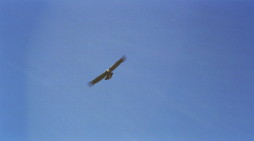 |
My excellent guide, Marianno, told me about that condors live monogamy in partnership whole their life.
The birds are known to live 40 - 50 years or more, and it is
likely that they are among the longest lived of all terrestrial birds. When one
partner dies, the other takes suicide by crashing directly against wall of the mountain.
Since the Condors
are so big and strong they can catch big preys on the ground. The condors
hunt in the morning or late afternoon. I have heard about condors that
they descend right down to kill and carry away baby alpacas and sheep and even push
full grown cows to their death over the cliff edges. I didn't hear about
stories where condors had attacked people, so that made me more relaxed to
bear in mind when some of the condors started to circle above me head.
A condor flight that reminds me about a plain. The condors glided
majestically from one edge of the cliff to another on the rising thermals
occurring as the air warms. They looked for a perfect best place for sunbathing.
| Photo. An rock figure in the shape of a
condor head and neck in Machu Picchu, the Inca's Lost City in Peru (near
the old Inca capital Cusco). |
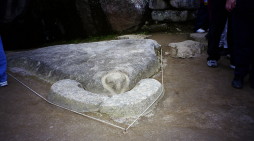 |
Some people believed that the
whole city could have been shaped as a condor. For many centuries
the condor has been revered by Andean civilizations, appearing prominently in pottery, stone
sculptures and even a gigantic figure etched into the desert surface of Peru's
Nazca Plains. Yet much remains unknown about these birds.
It is clear that Condors are formidable
scavengers, the undertakers of the natural world. They quickly clean up the
remains wherever death strikes, helping to prevent the spread of disease among
large mammals in the process. At the time of the Spanish conquest, the Andean
condor's silhouette was a common sight along the entire Andes cordillera.
Stein Morten Lund,
11 October 2002
Additional
information
Read more about Peru on this website: the people, the Amazon
jungle, cultural and archaeological treasures and more.
Some facts about the country:
·
Formal country name:
Republic of
Peru.
·
Area: 1.28 million sq km.
·
Population: 28 million.
·
People: 54% Indian, 32% Mestizo (mixed
European and Indian descent), 12% Spanish descent, 2% Black, Asian
minority
·
Language: Aymara, Quechua, Spanish;
Castilian.
·
Religion: Over 90% Roman Catholic, small
Protestant population.
·
Government: constitutional
republic.
Read more
about Peru
on our website:
·
Visit the ancient Inca capital of
Cuzco,
·
Explore the lost city of
Machu Picchu.
·
Study the enigma of the Nazca Lines. What
is really the purpose of these lines?
·
Experience the country`s beautiful
scenery, the Peruvian Andes.
·
Visit home to some of the millions of
highland Indians who still speak the ancient tongue of Quechua and maintain a
traditional way of life.
·
Get an adventure of life in the
Amazon
Basin, which
occupies half of Peru. Look
up for the puma!
Read more about Peru on this website: people, Amazon jungle, cultural and
archaeological treasures, and more.
